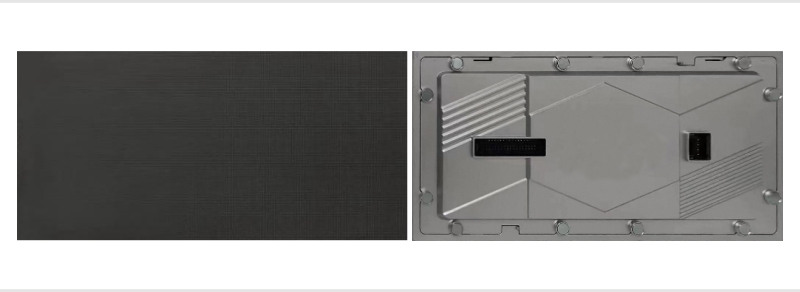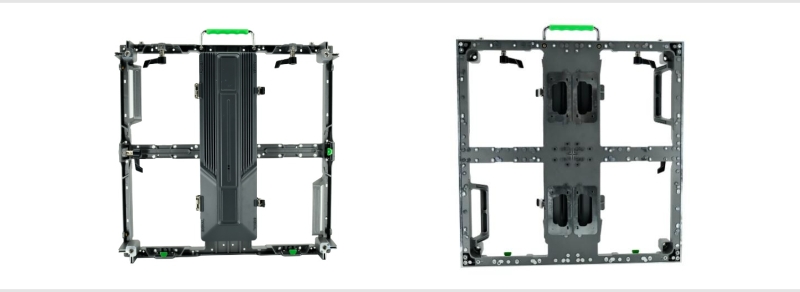When we make an LED display, we need to involve LED display hardware and software.
So what are the main components of a complete LED display, especially in addition to the LED screen itself, what are the accessories surrounding it? Which ones?
Through software and hardware, a complete LED display system is formed to realize functions such as video display.
In fact, the hardware components of an LED display mainly include LED modules, LED cabinets, power supplies, receiving cards, sending cards, video processors, signal sources, mounting brackets and power distribution systems.
LED module, also known as LED light panel, is the smallest detachable component unit at the application level of LED display.
Common LED modules include LED modules produced by DIP process, LED modules produced by SMD process and modules produced by COB process.

DIP and SMD LED module

COB LED module
LED modules produced by the DIP process are generally used outdoors, because the brightness of DIP LED modules can reach 6000CD/square to 10000CD/square.
LED modules produced by the SMD process are generally used indoors, because the spacing between SMD lamp beads can be made smaller and the display effect is more delicate.
1. LED cabinet
The LED cabinet is the basic unit of the LED display screen.
The LED modules are arranged according to certain rules, and then the LED modules are fixed to the LED cabinet through screws.
Common LED boxes include outdoor iron boxes and final aluminum boxes. as the picture shows:

Iron Waterproof LED Cabinet

Die-cast Aluminum LED Cabinet
2. Switch power supply
Generally, LED displays need to be powered by a 4.2V-5V DC low-voltage power supply.
So we use switching power supplies to convert high AC voltage into low voltage.
In order to increase the application area of LED display screens, the input voltage of switching power supplies generally used in the LED industry is AC100-240V and the power is 150V-400W.

220v-240v 110v-240v
3. Receiving card
The receiving card is used to receive the video signal sent by the sending card, and then transmit it to the LED module through the receiving card.
Therefore, the LED receiving card is the control center of the LED display, thereby controlling the normal display of the LED box.
Here we show Nova Technologies’ common receiving cards.

A5S MRV412
4. Sending card
The sending card is a receiving card that converts signals from front-end video sources (such as computers, video processors, media servers, etc.) and transmits them to the LED display.
The LED sending card is as shown in the figure:

MSD300
5. Video processor
With the development of the LED industry, traditional sending cards can only display HDMI, DVI and other signals.
If users want to display SDI camera signals or analog signals such as CVBS and VGA so that they can play the complete content, they need to use a video processor.
In addition, during the production process of LED displays, the difference in pixel pitch causes each screen to not have a standard resolution, resulting in incomplete pictures or black borders.
At this time, the zoom function of the video processor is needed to zoom or enlarge the image. as the picture shows:

VDWALL-615S
6. Signal source
If you want LED electronic displays to meet the needs of different environments, they must be powerful in terms of functionality.
It must be compatible with signal sources from different devices.
The main signal sources currently supplied to LED electronic displays on the market include computers, cameras, high-definition TVs, advertising machines, closed-circuit surveillance, mobile phones, etc.
7. Installation bracket
The LED display steel structure mounting bracket is the basic installation project of the display screen.
The LED display component uses the mounting bracket to firmly splice the LED screen body into a whole, and connect the screen body and the main body of the building together to bear the quality of the screen body and the external force.
It is also the installation basis for other equipment and exterior decoration. as the picture shows:

Indoor LED display steel structure
 Outdoor LED display steel structure
Outdoor LED display steel structure
9. Power distribution system
As the name implies, the power distribution system provides stable power supply for the LED display to ensure that related equipment can operate normally.
It is not to be mixed with other electrical equipment.
Usually the power distribution system is equipped with lightning protectors to prevent the LED display screen from being interrupted due to lightning and rainstorms. In severe cases, it may cause damage.

led display power distribution system
LEGIDATECH is an LED display manufacturer and LED display solution provider with 13 years of industry experience, providing cost-effective LED display products and after-sales services around the world.




